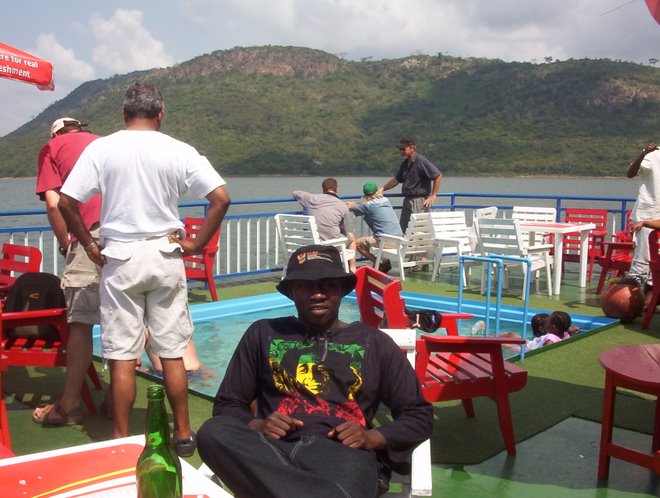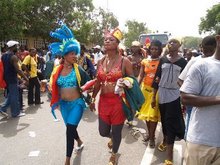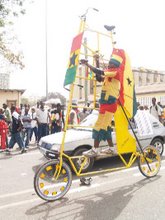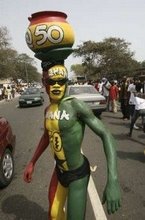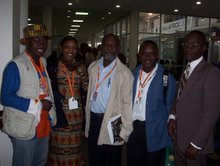Work begins on Sofoline Interchange
.JPG)
Construction work has begun in earnest on the Sofoline interchange in Kumasi. This has given hope to residents of Kumasi that the traffic congestion in one of the busiest roundabouts in the metropolis – Sofoline – would soon be a thing of the past. The contractor has started with the landscaping at the Sofoline roundabout towards the Bekwai roundabout. Traffic from the Abrepo junction and Patasi roads are to be directed to the Sunyani road through an underpass bridge. The construction of the interchange forms part of the 10.3 kilometre Komfo Anokye Teaching Hospital-Abuakwa dual carriageway corridor of the main Kumasi- Sunyani road rehabilitation project. The road has now been redesigned to be reconstructed into an asphaltic concrete surface dual carriageway.
.JPG)
The project involves five main components, mainly- the widening of the road from the KATH to Abuakwa, the construction of an interchange at KATH and the Sofoline, as well as the construction of five underpass bridges along the road and the landscaping of the entire road network. It will also cater for the landscaping of all road medians and selected open spaces abutting the road and within the interchange loops. While the contractors are doing the landscaping, at the Sofoline roundabout, work on the KATH stretch was yet to start. However, landscaping of the road has also started from the Sofoline towards the Bekwai roundabout. President J. A. Kufuor cut the sod last year for work to commence on the estimated ¢732 billion ($80 million) project.
.JPG) The Chinese construction firm, Messrs China Geo Engineering Corporation, is executing the project and it is being supervised by ABP Consulting Engineers from Ghana. Among the facilities that would be provided to curb the spate of accidents along the road, most of which claim lives and property, are bicycle lanes and pedestrian walkways. The 10.3 kilometre KATH-Abuakwa road links Kumasi to the Brong Ahafo and Western regions. The section from the KATH to Sofoline roundabout which is about two kilometres is to be a three lane dual carriageway, with the remaining 8.3 kilometre stretch being widened into a two lane dual carriageway. One of the interchanges will be at the Sofoline roundabout to ensure the free flow of traffic at the location, which is currently one of the traffic bottlenecks in the city.
The Chinese construction firm, Messrs China Geo Engineering Corporation, is executing the project and it is being supervised by ABP Consulting Engineers from Ghana. Among the facilities that would be provided to curb the spate of accidents along the road, most of which claim lives and property, are bicycle lanes and pedestrian walkways. The 10.3 kilometre KATH-Abuakwa road links Kumasi to the Brong Ahafo and Western regions. The section from the KATH to Sofoline roundabout which is about two kilometres is to be a three lane dual carriageway, with the remaining 8.3 kilometre stretch being widened into a two lane dual carriageway. One of the interchanges will be at the Sofoline roundabout to ensure the free flow of traffic at the location, which is currently one of the traffic bottlenecks in the city.
.JPG) A second two level interchange to control vehicular movement will also be constructed at the KATH roundabout, while five underpass bridges would be developed at the University of Education Winneba (UEW) Kumasi campus, Institute of Planning and Technology (IPT), Agric College, Apatrapa and South Suntreso junctions to facilitate the smooth flow of vehicular traffic at that section of the Kumasi metropolis. The project has been designed such that traffic will be separated at those five major junctions with dense and heavy traffic. The absence of an adequate infrastructural development, including road network in Kumasi, has undermined economic development in the metropolis.
A second two level interchange to control vehicular movement will also be constructed at the KATH roundabout, while five underpass bridges would be developed at the University of Education Winneba (UEW) Kumasi campus, Institute of Planning and Technology (IPT), Agric College, Apatrapa and South Suntreso junctions to facilitate the smooth flow of vehicular traffic at that section of the Kumasi metropolis. The project has been designed such that traffic will be separated at those five major junctions with dense and heavy traffic. The absence of an adequate infrastructural development, including road network in Kumasi, has undermined economic development in the metropolis. .JPG) The government has, however, given a promise to initiate the necessary programmes that would reduce traffic congestion in Kumasi to facilitate the free movement of goods, services and persons. Apart from the KATH-Abuakwa road, the government has hinted that it would develop the main arterial roads at Antoa, Offinso, Barekese, Sunyani, New and Old Bekwai as well as the Lake Road which converge at Kumasi. These roads are connected by the ring road which serves as the wheel, but lacks fluidity and connectivity in the flow of traffic due to the bottlenecks at some intersections, including those of Oforikrom, the Asafo Market, Asokwa, the Santasi, Sofoline and Suame roundabouts.
The government has, however, given a promise to initiate the necessary programmes that would reduce traffic congestion in Kumasi to facilitate the free movement of goods, services and persons. Apart from the KATH-Abuakwa road, the government has hinted that it would develop the main arterial roads at Antoa, Offinso, Barekese, Sunyani, New and Old Bekwai as well as the Lake Road which converge at Kumasi. These roads are connected by the ring road which serves as the wheel, but lacks fluidity and connectivity in the flow of traffic due to the bottlenecks at some intersections, including those of Oforikrom, the Asafo Market, Asokwa, the Santasi, Sofoline and Suame roundabouts.  There are also some missing links on the road network, especially along the Oforikrom-Asokwa-Ahodwo and Sofoline link road. The delay in developing the link roads had undermined the smooth flow of vehicular traffic in the metropolis. By providing the requisite infrastructure in Kumasi, the metropolis would be able to play its role as a modern city, which is not only strategically located to enhance business transactions, but also a centre of vibrant economic, cultural, tourist and political activities in the country.
There are also some missing links on the road network, especially along the Oforikrom-Asokwa-Ahodwo and Sofoline link road. The delay in developing the link roads had undermined the smooth flow of vehicular traffic in the metropolis. By providing the requisite infrastructure in Kumasi, the metropolis would be able to play its role as a modern city, which is not only strategically located to enhance business transactions, but also a centre of vibrant economic, cultural, tourist and political activities in the country.

.JPG)
.JPG)
.JPG)
.JPG)




.JPG)
.JPG)

.JPG)


